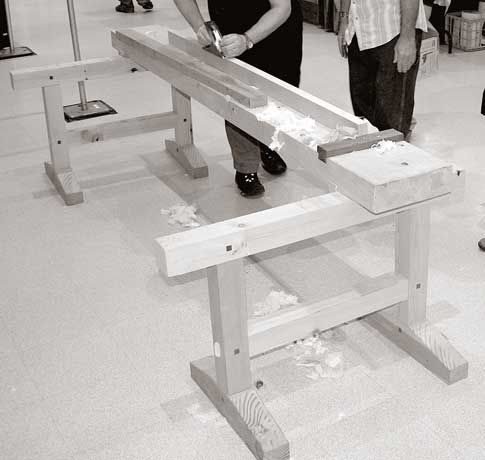We may receive a commission when you use our affiliate links. However, this does not impact our recommendations.
 One of my (many) blind spots in woodworking is Japanese tools and shop practices. Sure, I’ve read Toshio Odate’s excellent autobiography, plus “The Genius of Japanese Carpentry.” And I drool with great regularity on the Japan Woodworker catalog.
One of my (many) blind spots in woodworking is Japanese tools and shop practices. Sure, I’ve read Toshio Odate’s excellent autobiography, plus “The Genius of Japanese Carpentry.” And I drool with great regularity on the Japan Woodworker catalog.
But I understand Japanese shop practices as much as I understand all the acronyms my 12-year-old daughter uses when texting. DFLA!
So I’m always eager to learn about Japanese woodworking from people who have studied and practiced it in Japan. One of those people is Harrelson Stanley, the owner of JapaneseTools.com and the man who brought Shapton waterstones to American shores.
Stanley completed the furniture program at the premier North Bennett Street School as a very young man and then went off to Japan to study the traditional lacquering and woodworking trades. He came back to this country with a Japanese wife and a deep desire to spread the traditional Japanese practices among Western woodworkers.
This weekend at the Northeastern Woodworkers Association’s annual show, Stanley was demonstrating his new Sharp Skate honing guide, teaching people to sharpen edge tools and helping people learn to wield a handplane on his Japanese bench.
The bench consists of two trestle-style sawhorses that are topped with one massive slab of a top. Except for the teak planing stop, all the bench’s parts are made using Port Orford Cedar, Stanley says, a durable and strong member of the cypress family that grows in the Pacific Northwest.
This particular bench was built by James Blauvelt, a Connecticut cabinetmaker, joiner and carpenter who runs the company Bluefield Joiners. But is this bench typical of what would be found in a Japanese workshop?
“Actually, it’s a little too nice,” Stanley says. “In a Japanese shop they would use something more makeshift.”
 Harrelson Stanley demonstrates how the notch in the top is used to true a plane’s sole.
Harrelson Stanley demonstrates how the notch in the top is used to true a plane’s sole.
Here are some of the critical dimensions: The trestles are made from 3-1/2″ x 3-1/2″ stock throughout, with an overall height of 23-3/4″ from the floor to the top of each sawhorse. The top is 3-1/2″ thick, 10-1/4″ wide and 8′ long. The working height of the benchtop is 27-1/2″, which is fairly low by modern Western standards.

The slab rests on the sawhorses and is held in place by a single cleat below the top that fits against the top of one of the sawhorses. Gravity and the force of the work keeps the top in place.
The top is considerably narrower than the sawhorses, which prompted me to ask why. Is that where stock was placed before or after it was worked? Not really, Stanley says. Typically, the Japanese woodworker would place a thin board across the two trestles and place the tools he or she needed on that board. Because this board is thin, it typically kept the tools out of the way of the work.
Another interesting feature of the benchtop is a triangular notch cut into the slab up near the planing stop. This notch holds Japanese planes with their soles facing up so the craftsman can dress the tool’s wooden sole with another plane.
As I was taking a few photos of the bench, one of Stanley’s daughters, Abby, demonstrated her planing skills on a piece of Port Orford Cedar (that wasn’t part of the workbench). After taking a couple warm-up passes, she pulled off a beautiful shaving that was almost entirely full width and full length. And, as you can see, the bench wasn’t too high for her.
Here are some supplies and tools we find essential in our everyday work around the shop. We may receive a commission from sales referred by our links; however, we have carefully selected these products for their usefulness and quality.







[as my kids write on their game forums] First comment!
I like this bench. It’s portable, and at the right height for me (I’m 5’2", and never trust Chris’ height recommendations).
But Japanese woodworking must be a lot different than European. I can’t see how this rig would be used to hold wood in the three different orientations, or how it would hold up to serious chisel-chopping. It looks perfect for planing fairly narrow boards, and not much else.
So I guess I’ll still dream about the day when my skills are up to making a Roubo, and keep arguing with myself about how much to chop off the legs.
–Liz